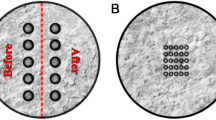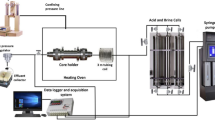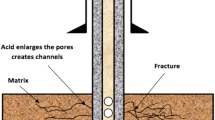Abstract
Matrix acidizing is vital to enhance the production of tight carbonate formations. In weak carbonate rocks or acid over-dissolution, the rock is prone to failure upon developing wormholes. Strengthening agents can play a significant role in mitigating failure and supporting more extended productivity. In this study, we tested 0.1 M and 0.2 M zinc sulfate (ZnSO4) and 0.5 M diammonium phosphate ((NH4)2HPO4) as strengthening agents, which change the dominant host mineral into harder ones. Both agents were tested on two different types of acidized (i.e., wormholed) carbonate rocks, specifically Austin chalk and Indiana limestone. The impulse hammer and acoustics measurements evaluated the carbonate rocks’ mechanical properties before and after the treatment. In addition, scanning electron microscopy energy-dispersive X-ray spectroscopy (SEM–EDS) and scanning electron microscopy (SEM) were used to affirm the change of rock mineralogy into harder minerals after the treatment. The chemical treatment caused no noticeable change in the wormhole size and shape, as revealed by the scanned micro-computed tomography (micro-CT) images. The chemical treatment of the samples was conducted by core flooding the plugs at high pressure and temperature with 4–5 pore volumes of the chemicals and leaving them in the treatment solution for 72 h. As a result of the formation of harder minerals, the mechanical properties after the treatment showed improvement. Zinc sulfate raised the surface rock hardness of limestone by 16%, while diammonium phosphate showed a 30% increase when evaluated with the same technique. The most noticeable improvement happened to chalk after treatment with diammonium phosphate. Chalk impulse hammer hardness almost quadrupled with the diammonium phosphate. The acoustics measurements showed a similar result to the impulse hammer through an increase in the dynamic Young’s modulus and a decrease in Poisson’s ratio.










Similar content being viewed by others
References
Abass HH, Al-Mulhem AA, Alqam MH, Khan MR (2006) Acid fracturing or proppant fracturing in carbonate formation? A rock mechanics view. Spe Ann Tech Conf Exhib. https://doi.org/10.2118/102590-MS
Aldakkan B, Al Moajil AM, Alnoaimi K (2018) “Carbonate acidizing and flowback analysis- a review and an evaluation method”, presented at the. IADC/SPE Asia Pacif Drill Technol Conf and Exhib. https://doi.org/10.2118/191017-MS
Aljawad MS, Desouky M, Sølling TI, Amao AO, Al-Ramadan K (2020) “Improving carbonate rock hardness by consolidating additives to sustain long term fracture conductivity.” J Pet Sci En 195:107897. https://doi.org/10.1016/j.petrol.2020.107897
Barri A, Mahmoud M, Elkatatny S (2016) Evaluation of Rock Mechanical Properties Alteration During Matrix Stimulation With Chelating Agents. J Energy Resour Technol. Doi 10(1115/1):4032546
Bauer A, Walle LE, Stenebråten J, Papamichos E (2013) Impact of Acidizing-Induced Wormholes in Chalk on Rock Strength presented at the 47th U.S. Rock Mechanics/Geomechanics Symposium, Jun. 2013. https://onepetro.org/ARMAUSRMS/proceedings/ARMA13/All-ARMA13/ARMA-2013-534/121116. Accessed 14 Apr 2022
Coulter G (2012) Technology focus: well stimulation (june 2012). J Pet Technol 64(06):90. https://doi.org/10.2118/0612-0090-JPT
Desouky M, Aljawad MS, Solling T, Abduljamiu A, Norrman K, Alshehri D (2021) Improving long-term hydraulic fracture conductivity by alteration of rock minerals. J Pet Sci Eng 196:108046. https://doi.org/10.1016/j.petrol.2020.108046
Dong R, Wang Q, Wheeler M F. (2022) Prediction of Mechanical Stability of Acidizing-Induced Wormholes Through Coupled Hydro-Chemo-Mechanical Simulation,” presented at the 53rd U.S. Rock Mechanics/Geomechanics Symposium, Jun. 2019. https://onepetro.org/ARMAUSRMS/proceedings/ARMA19/All-ARMA19/ARMA-2019-0011/124604. Accessed: 14 Apr. 2022
Gou B, Zeng M, Guo J, Lai J, Liu Z, Zhou H. Ma C, Liu F (2022)“Effects of Hydrochloric Acid on the Mechanical and Elastic Properties of Tight Dolomite,” presented at the ARMA-CUPB Geothermal International Conference, Aug. 2019. https://onepetro.org/ARMACUPB/proceedings/CUPB19/All-CUPB19/ARMA-CUPB-19-9032/125196. Accessed 14 Apr 2022
Jahani N, Berge G, Haugen B (2014a) Prediction of rock strength with matrix acidizing stimulation and induced wormhole by computational simulation methods. In: Alejano L, Perucho Á, Olalla C, Jiménez R (eds) Rock Engineering and Rock Mechanics: Structures in and on Rock Masses. CRC Press, Florida
Jahani N, Berge G, Haugen B (2022) “Prediction of Rock Strength with Matrix Acidizing Stimulation and Induced Wormhole by Computational Simulation Methods,” presented at the ISRM Regional Symposium - EUROCK 2014b, May 2014b. https://onepetro.org/ISRMEUROCK/proceedings/EUROCK14/All-EUROCK14/ISRM-EUROCK-2014b-213/40263. Accessed 14 Apr. 2022
King GE (1986) Acidizing concepts - matrix vs. fracture acidizing. J Pet Technol 38(05):507–508. https://doi.org/10.2118/15279-PA
Mahmoud M, Aljawad MS, Kamal MS, Shakil Hussain SM (2020) Sandstone acidizing using a new retarded acid system based on gemini surfactants. J Pet Sci Eng 194:107459. https://doi.org/10.1016/j.petrol.2020.107459
McDuff DR, Shuchart CE, Jackson SK, Postl D, Brown JS (2010) “Understanding wormholes in carbonates: unprecedented experimental scale and 3-D visualization. SPE Ann Tech Conf Exhib. https://doi.org/10.2118/134379-MS
Melendez MG, Pournik M, Zhu D, Hill AD (2007) The effects of acid contact time and the resulting weakening of the rock surfaces on acid fracture conductivity. Europe Form Damage Conf. https://doi.org/10.2118/107772-MS
Morita N, Doi T, Kinoshita T (2002) Stability of an openhole completed in a limestone reservoir with and without acid treatments. SPE AnnTech Conf Exhib. https://doi.org/10.2118/77776-MS
Morsy S, Hetherington CJ, Sheng JJ (2015) Effect of low-concentration HCl on the mineralogy, physical and mechanical properties, and recovery factors of some shales. J Unconv Oil Gas Resour 9:94–102. https://doi.org/10.1016/j.juogr.2014.11.005
Mustafa A, Aly M, Aljawad MS, Dvorkin J, Solling T, Sultan A (2021) “A green and efficient acid system for carbonate reservoir stimulation.” J Pet Sci Eng 205:108974. https://doi.org/10.1016/j.petrol.2021.108974
Mustafa A, Alzaki T, Aljawad MS, Solling T, Dvorkin J (2022) Impact of acid wormhole on the mechanical properties of chalk, limestone, and dolomite: experimental and modeling studies. Energy Rep 8:605–616. https://doi.org/10.1016/j.egyr.2021.11.249
Nasr-El-Din HA, Al-Driweesh SM, Metcalf AS, Chesson JB (2008) Fracture acidizing: what role does formation softening play in production response? SPE Prod Oper 23(02):184–191. https://doi.org/10.2118/103344-PA
Omer M, Fragachan FE, Rodriguez CC (2020) No more premature collapse of acid wormholes: extend wells productivity with particulate diversion technique modelling. Abu Dhabi Int Petrol Exhib Conf. https://doi.org/10.2118/202670-MS
Safari R, Fragachan E F (2022) Near Wellbore Carbonate Rock Failure Model With Acid-Weakening Effects,” presented at the 52nd U.S. Rock Mechanics/Geomechanics Symposium, Jun. 2018. https://onepetro.org/ARMAUSRMS/proceedings/ARMA18/All-ARMA18/ARMA-2018-909/122694. Accessed 14 Apr., 2022
Samarkin Y, Aljawad MS, Amao A, Solling T, Abu-Khamsin SA, Patil S, AlTammar MJ, Alruwaili KM (2022) Carbonate rock chemical consolidation methods: advancement and applications. Energy Fuels 36:4186–4197. https://doi.org/10.1021/acs.energyfuels.2c00232
Samarkin Y, Amao A, Aljawad MS, Solling T, Norman K, Al-Ramadan K, AlTammar MJ, Alruwaili KM (2022) Hardness Enhancement of carbonate rocks by formation of smithsonite and fluorite. Rock Mech Rock Eng 55(2):1001–1012. https://doi.org/10.1007/s00603-021-02701-x
Samarkin Y, Aljawad MS, Amao A, Solling T, Al-Ramadan K, Abu-Khamsin S, Patil S, AlTammar MJ, Alruwaili KM (2022) Hydraulic fracture conductivity sustenance in carbonate formations through rock strengthening by DAP Solution. Int Petrol Technol Conf. https://doi.org/10.2523/IPTC-22496-MS
Sassoni E, Naidu S, Scherer GW (2011) The use of hydroxyapatite as a new inorganic consolidant for damaged carbonate stones. J Cult Herit 12(4):346–355. https://doi.org/10.1016/j.culher.2011.02.005
Walle L E, Papamichos E (2022)“Acidizing of Hollow Cylinder Chalk Specimens and its Impact on Rock Strength and Wormhole Network Structure,” presented at the 49th U.S. Rock Mechanics/Geomechanics Symposium, Jun. 2015. https://onepetro.org/ARMAUSRMS/proceedings/ARMA15/All-ARMA15/ARMA-2015-566/65773. Accessed 14 Apr., 2022.
Wang Y, Hill AD, Schechter RS (1993) The optimum injection rate for matrix acidizing of carbonate formations. SPE Annual Tech Conf Exhib. https://doi.org/10.2118/26578-MS
Zhang Y, Sarmadivaleh M, Lebedev M, Barifcani A, Rezaee R, Testamantia N, Iglauer S (2016) Geo-mechanical weakening of limestone due to supercritical CO2 Injection. Offshore Technol Conf Asia. https://doi.org/10.4043/26470-MS
Zhang H, Zhong Y, Zhang J, Zhang Y, Kuang J, Yang B (2020) Experimental research on deterioration of mechanical properties of carbonate rocks under acidified conditions. J Pet Sci Eng 185:106612. https://doi.org/10.1016/j.petrol.2019.106612
Author information
Authors and Affiliations
Corresponding author
Ethics declarations
Conflict of Interest
The authors have no competing interests to declare that are relevant to the content of this article.
Additional information
Publisher's Note
Springer Nature remains neutral with regard to jurisdictional claims in published maps and institutional affiliations.
Rights and permissions
Springer Nature or its licensor (e.g. a society or other partner) holds exclusive rights to this article under a publishing agreement with the author(s) or other rightsholder(s); author self-archiving of the accepted manuscript version of this article is solely governed by the terms of such publishing agreement and applicable law.
About this article
Cite this article
Mustafa, A., Desouky, M., Aljawad, M.S. et al. Sustaining Wormholes Mechanical Stability in Weak Acidized Carbonates Using Consolidants. Rock Mech Rock Eng 56, 4291–4302 (2023). https://doi.org/10.1007/s00603-023-03285-4
Received:
Accepted:
Published:
Issue Date:
DOI: https://doi.org/10.1007/s00603-023-03285-4




